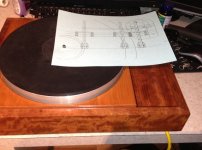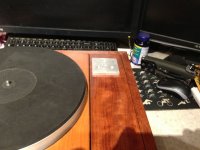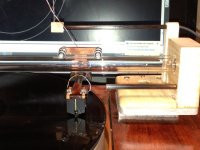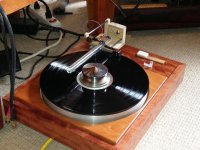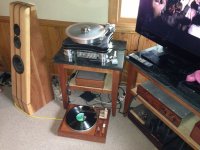It Works!!!!
Here are the final assembly photos and some pictures of it running. The base plate fits in the "standard" location for a normal tonearm. The arm is then bolted to it. This give 3axis of adjustment to final align it. I did not instal a cue arm as I felt it is just too simple to lift it manually. The head amp is a Salas simple JFET with 58dB gain. My Phenix has never sounded better. Prior to this arm it had a Magnapan Unitrac I. Included is a photo of the jig I used to set the arm up with.
Impression:
It is a very detailed and quick sounding arm. Bass is strong and VERY tight. This set-up will make your eyes blink with a rim shot. Presently it is running the Denon103r cartridge on my Phoenix turntable. In the last photo is the competition. A Black Onyx/Triplaner VII/Lyra Kleous. This is a new 103r so before I do some serious listening impressions it needs to break in.
FYI, This was built with a 16mm heavy wall tube not the 10mm. No tracking problems, however I did adjust for the size with the bearing spacing. I will cut back the tube and pack it with sand soon. (maybe coffee creamer since the ends are to be sealed.
Here are the final assembly photos and some pictures of it running. The base plate fits in the "standard" location for a normal tonearm. The arm is then bolted to it. This give 3axis of adjustment to final align it. I did not instal a cue arm as I felt it is just too simple to lift it manually. The head amp is a Salas simple JFET with 58dB gain. My Phenix has never sounded better. Prior to this arm it had a Magnapan Unitrac I. Included is a photo of the jig I used to set the arm up with.
Impression:
It is a very detailed and quick sounding arm. Bass is strong and VERY tight. This set-up will make your eyes blink with a rim shot. Presently it is running the Denon103r cartridge on my Phoenix turntable. In the last photo is the competition. A Black Onyx/Triplaner VII/Lyra Kleous. This is a new 103r so before I do some serious listening impressions it needs to break in.
FYI, This was built with a 16mm heavy wall tube not the 10mm. No tracking problems, however I did adjust for the size with the bearing spacing. I will cut back the tube and pack it with sand soon. (maybe coffee creamer since the ends are to be sealed.
Attachments
Last edited:
take it back..further investigation has found the sound is getting transmitted to the needle through the platter, not the arm assembly...The platter is a bell!..Bear is right it needs dampening
Last edited:
Nice build SGregory, that is the first thing I noticed once built up was its speed and phenomenal PRAT. I noticed a few threads back concerning antiskating, and riding a groove wall more. I have not noticed any of this and also at the same time there is not just a side force but a pulling force forward in the groove/stylus relationship, it's this pull forward that creates the side force in a pivoted arm since the headshell is offset towards the spindle. A linear arm is not advancing through a simple side force, it's a combination of the groove advancing and the forward pull which in 90 degrees to the horizontal movement causes no skating force. Muddy is the furthest from the sound of this arm, as those who have built it can attest to, it revels in detail and deep tight bass.
Colin
Colin
Last edited:
FYI, This was built with a 16mm heavy wall tube not the 10mm. No tracking problems, however I did adjust for the size with the bearing spacing. I will cut back the tube and pack it with sand soon. (maybe coffee creamer since the ends are to be sealed.
Hi S; what type of tubing is that - what is it sold as/for? And it looks as if you've simply made it an interference fit in the wood block - is that right?
Cheers
Stuey
Stuey,
The tubing is 16mm Borosilicate glass(pyrex). Obtained it from a glass blower, but I did see some forsale on EPay a while back. It is an interference fit with the wood block. Used a 5/8 forstner bit to drill the hole and then ran a coil of fine sandpaper through it to get sizing just right. In fact all of the tubing is press fit, including the CF tubes. The wood I used is hard curly maple, ebony, and bubinga, which are pretty stable.
The tubing is 16mm Borosilicate glass(pyrex). Obtained it from a glass blower, but I did see some forsale on EPay a while back. It is an interference fit with the wood block. Used a 5/8 forstner bit to drill the hole and then ran a coil of fine sandpaper through it to get sizing just right. In fact all of the tubing is press fit, including the CF tubes. The wood I used is hard curly maple, ebony, and bubinga, which are pretty stable.
@ chokesrule: following this thread, I have wondered how susceptible this design would be to external vibration. all systems are and all of the critical links in this one look very live to me. damping has been discussed a bit. I can only only offer that in my attempts to enhance isolation, layers of some lossy material have been effective. I think the interface between the granite block and your table's base as well as the attachment of the arm tube to it's mount are both areas where the proper material might bring down some of the microphonic tendency. I have had good results with the type of material used in car audio to damp door panels ( i know it used to be an asphalt-doped polymer, might have evolved). I would place this between the granite block and the plinth. felt would be a quick and easy test too. O-rings at the arm tube to acrylic block is another thought. biggest issue is knowing what's getting thru. perhaps a transducer (driven by a sweep) mounted to the base of the table and using the cartridge for read-back, throughput could be measured? just my two cents 🙂
pcb
Thanks for the advice, I am open to all ideas. I don't really know anything about turntables. I glued some floor acoustic insulation under the platter and used it as an extra mat on top. The arm is great as I can easily be altered to take the extra height of the record due to the new width
The ringing of the platter was cured. But it was to no avail. As when I tap , it comes thru load and clear. I will give your ideas a go later this week when I got time and I will also build Bears sand box.
Thanks for the advice, I am open to all ideas. I don't really know anything about turntables. I glued some floor acoustic insulation under the platter and used it as an extra mat on top. The arm is great as I can easily be altered to take the extra height of the record due to the new width
The ringing of the platter was cured. But it was to no avail. As when I tap , it comes thru load and clear. I will give your ideas a go later this week when I got time and I will also build Bears sand box.
I was looking at the photos of the arm from above and had some thoughts.
Just some random thoughts though... I have only been reading about that thing for a couple of days.
Since it is kind of an objective to get the arm to get lower mass, could it work to move the triangle thingy on the front of the glass tube?
That would move the balance point closer to the cartridge, so the axle that holds it can be shorter. This will also mean that we would need a smaller weight on the back for the VTF.
That reduced length could also eliminate any lever effects we could be facing because of the length of the cartridge's axle.
Just some random thoughts though... I have only been reading about that thing for a couple of days.
Since it is kind of an objective to get the arm to get lower mass, could it work to move the triangle thingy on the front of the glass tube?
That would move the balance point closer to the cartridge, so the axle that holds it can be shorter. This will also mean that we would need a smaller weight on the back for the VTF.
That reduced length could also eliminate any lever effects we could be facing because of the length of the cartridge's axle.
The pivot point is the center of the tubing in either design. Meaning that with the triangle thingy in front you would need more mass to balance it.
Another thing that just came to me.
Colin's design with the two bearings per triangle corner, looks that it might keep the carriage parallel even if there was only one set of bearings keeping the carriage dangling.
It would create some sort of unipivot thingy 🙂 Could it work?
Colin's design with the two bearings per triangle corner, looks that it might keep the carriage parallel even if there was only one set of bearings keeping the carriage dangling.
It would create some sort of unipivot thingy 🙂 Could it work?
Dimkasta,
It would hang but would sacrifice rigidity in most planes, there would be a hellish side to side play that would throw all goals out the window in stylus tangency as the quick to the point answer to a single pair of bearings.
Colin
It would hang but would sacrifice rigidity in most planes, there would be a hellish side to side play that would throw all goals out the window in stylus tangency as the quick to the point answer to a single pair of bearings.
Colin
The pivot point is the center of the tubing in either design. Meaning that with the triangle thingy in front you would need more mass to balance it.
Hmmm I forgot the mass of the triangle which is a bit more significant by being further away from the pivot. It actually works nicely there reducing the required weight on the back. Actually, if the bearing axles were super light, we could probably minimize the back weight by pulling the triangle further to the back.
dimkasta, You are right regarding moving the triangle back to reduce weight. I think the limit becomes the rigidity of materials used, ability to adjust VTF for different cartridges and the cue process.
In the final version, mine weighs in at 22 grams, including cartridge and wire.
In the final version, mine weighs in at 22 grams, including cartridge and wire.
There is enough info in the thread to make it. In my case I drew it up for my system based on the info and then built it. This build doesn't take very long, meaning don't over think it the first time. I will let V.A. post the dimensions if he wants to.
Dimkasta,
Imho the most important part of the build is carriage mass and bearing arrangement. There have been some accidental benefits with this arrangement that came to light as the design went in which is mentioned.in the thread. Materials being such a short arm and as long as they are light but rigid seem to have minimal impact on the overall sound, but subtle impact in finer points. Carbon fiber seems to my ears to be reigning champ however. Also for the glass tube system, the goal here is also rigidity with adjustment, but keep it simple so that it doesnt become a symphony of resonances.
Colin
Imho the most important part of the build is carriage mass and bearing arrangement. There have been some accidental benefits with this arrangement that came to light as the design went in which is mentioned.in the thread. Materials being such a short arm and as long as they are light but rigid seem to have minimal impact on the overall sound, but subtle impact in finer points. Carbon fiber seems to my ears to be reigning champ however. Also for the glass tube system, the goal here is also rigidity with adjustment, but keep it simple so that it doesnt become a symphony of resonances.
Colin
Last edited:
Stuey,
The tubing is 16mm Borosilicate glass(pyrex). Obtained it from a glass blower....
Excellent, thanks.
I have a question.... for the arm material would polycarbonate tubing be adequate (what the cartridge will attach to) or will I run into issues with that? I want to get carbon fiber, but also looking at alternatives. I was looking at this material:
CLEAR POLYCARBONATE TUBE Plastic Tubing
Opinions please. Also what diameter of tubing whatever the material would work best? I obviously don't want the tube to be too large as that would add mass, nor too small since that would probably flex.
CLEAR POLYCARBONATE TUBE Plastic Tubing
Opinions please. Also what diameter of tubing whatever the material would work best? I obviously don't want the tube to be too large as that would add mass, nor too small since that would probably flex.
I have a question.... for the arm material would polycarbonate tubing be adequate
Moray talked of this a couple times in this thread. Glass is the recommendation, poly is soft.
Just for the record- does anyone know the outer/inner dia of the slotted Cantus tube?
@ArouraB- It is definitely what is called heavy walled. I believe 2-2.5mm thick. It is blowers glass, Size I don't know.
- Home
- Source & Line
- Analogue Source
- DIY linear tonearm
